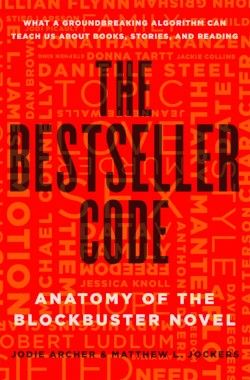
What’s the formula for a bestselling book? If you’re a writer aspiring to reach the New York Times bestseller list, you’ve probably asked yourself what those bestselling authors know that you don’t. Perhaps you’ve wished you could compile all the information about those bestselling books and see what they have in common. Jodie Archer and Matthew Jockers have done exactly that. They’ve hacked The Bestseller Code.
In their new book, The Bestseller Code; Anatomy of the Blockbuster Novel, Archer and Jockers describe what their algorithms and thousands of computer hours have uncovered: the recipe for a New York Times bestseller. This work describes their process and results in just enough detail. It is full of great insights into what sets a bestseller apart.
By compiling a digital collection of the NYT bestselling novels for the last several years, Jockers and Archer were able to create computer programs to identify commonalities. Books on the NYT bestseller list have a particular proportion of adjectives to nouns. They also have a consistent proportion of adverbs to verbs. Text mining also revealed that these bestselling titles also shared a lower number of major thematic elements received a majority of attention and had fewer, ancillary themes that supplied the story’s backdrop. (Less is more.)
On the subjects of sex, vocabulary, and plot form, there were interesting findings. Scenes involving sex tended to first appear about halfway through a novel. Sex was neither gratuitous nor occurred too frequently in the bestseller. Descriptions in the book were often told simply and without flowery vocabulary. Popular fiction novels featuring basic descriptions and common vocabulary scored higher on the computer-identified scales. Books that read naturally and with less pomp and puffery scored higher, too. Each bestseller fit into one of seven identifiable plot models. Adhering well to one of the seven plot paths, books of different themes, genres, and DNA could perform similarly.
The authors that could write more concisely and in an active voice were more successful. Who are these authors? Many of them have backgrounds in marketing and journalism, while others possess their Master of Fine Arts degree and/or have painstakingly honed their craft for many years.
The Bestseller Code reveals is that there is a recipe one can follow to write a book with a better chance at sales success—if one can write naturally in a style that concisely tells their story. Fewer long-winded description and two dollar words; focus in an active style and voice. Applying these findings to one’s writing may result in a book closer to the ideal, as revealed by the computer analysis of the NYT bestsellers. If you’ve come to authorship by way of journalism, marketing, or years of practice, you may be able to write a novel with greater potential still.
Those that aspire to hack the secrets of the NYT bestseller list, should check out The Bestseller Code (St. Martin’s Press) when it’s released September 20.
Redbrush helps business people, thought leaders, entrepreneurs, and speakers elevate their content and leverage their expertise into professional, published books.

